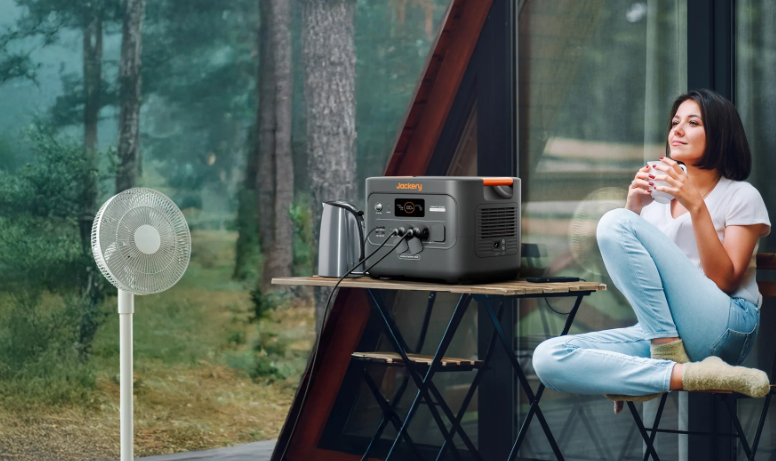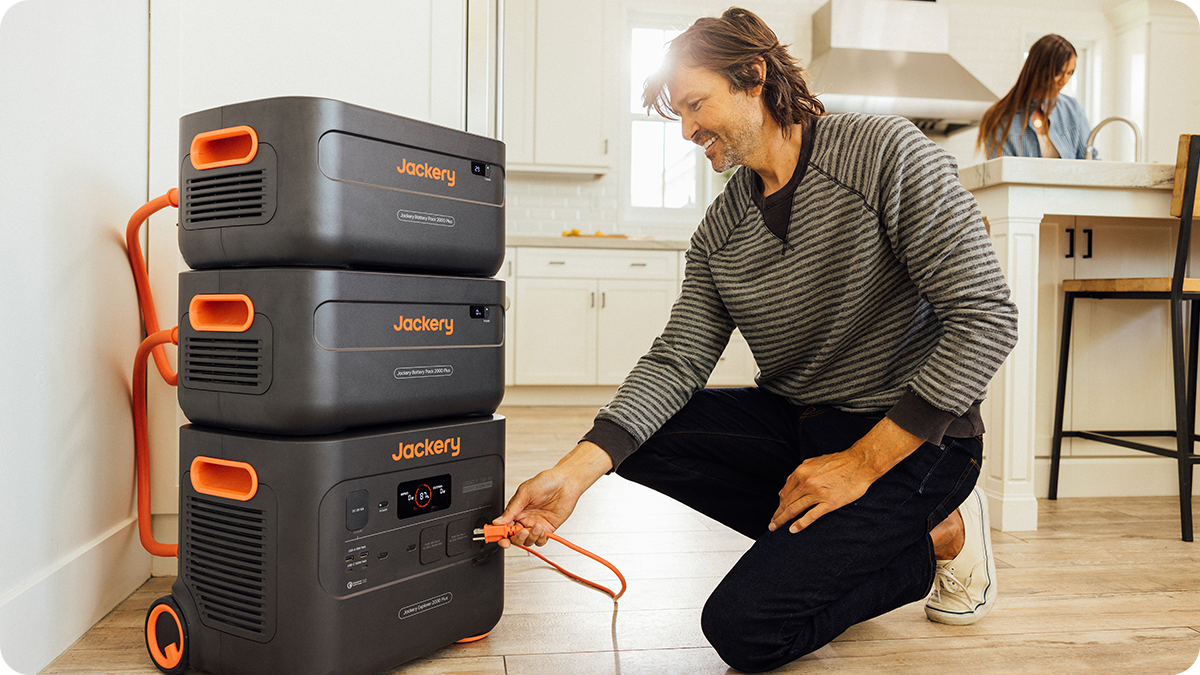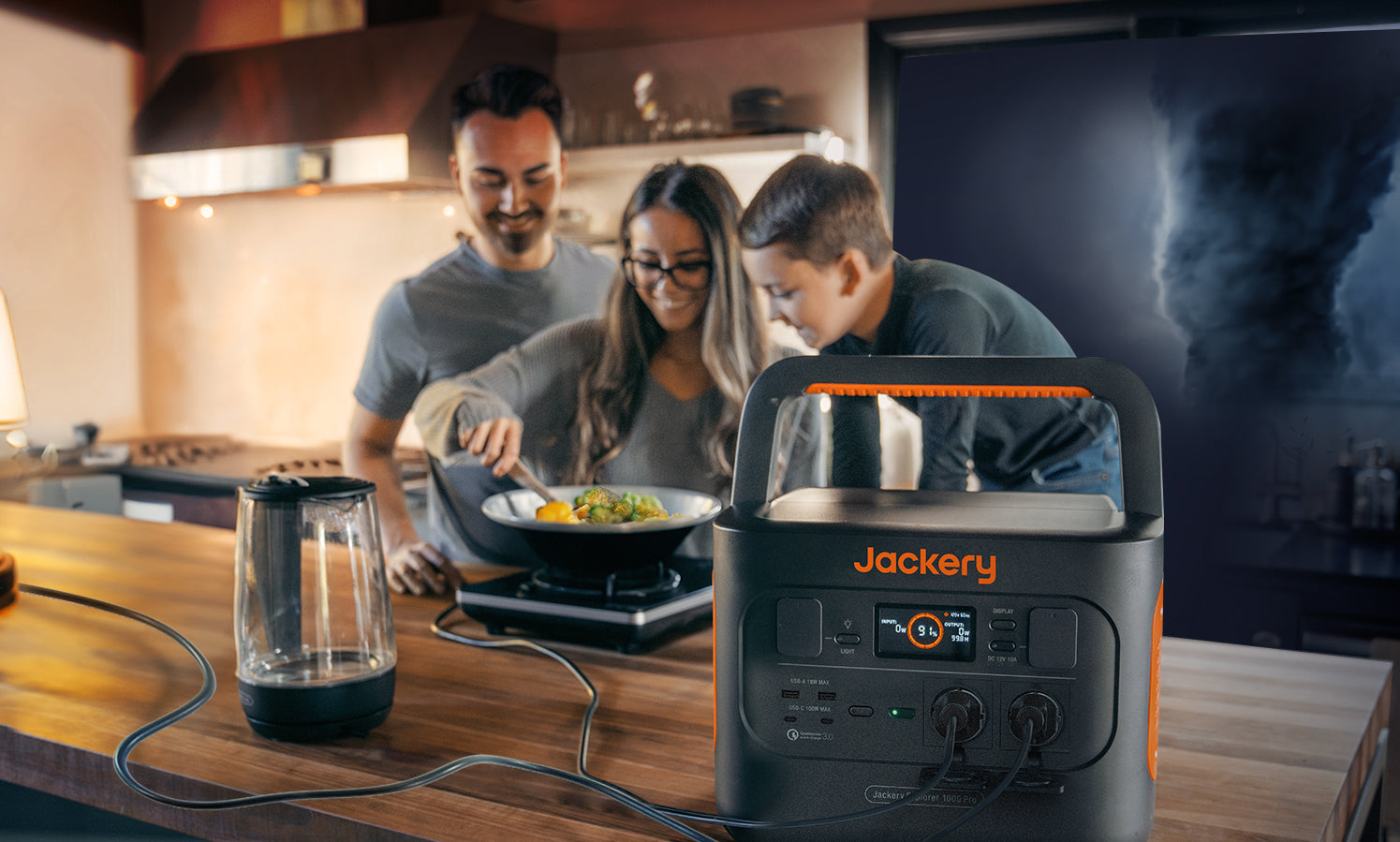A power station 230V is a portable energy solution designed to deliver the standard European voltage, making it ideal for running household appliances, tools, and devices. Whether you are camping, working remotely, or preparing for emergencies, a 230V power station can ensure stable, off-grid electricity when you need it most.
In this guide, we will learn more about a 230V solar power station, explore the appliances it can reliably power, and why a solar-powered generator is a smart and sustainable investment.
Understanding 230V Power Stations
Power stations are gaining popularity across Europe, particularly as more people adopt portable energy solutions for camping, home backup, and outdoor work.
If you are considering investing in one, understanding what a power station 230V is and how it differs from other types of power stations is essential. Here is a detailed breakdown to help you make informed decisions.
What is A 230V Power Station?
A power station 230V is a portable power supply system equipped with an AC output that delivers 230 volts of electricity—Europe's standard voltage. These power stations are typically battery-powered and often support solar charging, making them part of the solar power station category.
One of the key features of a high-quality 230V power station is its pure sine wave inverter. This ensures that the AC output closely mimics the smooth waveform provided by your home’s electrical grid. Why does that matter? Because sensitive electronics, such as laptops, CPAP machines, and appliances with motors, require a stable and clean power supply to operate safely and efficiently. A pure sine wave inverter ensures compatibility and prevents damage or performance issues.
Why 230V Matters in Europe?
The 230V standard is used across most of Europe, along with a frequency of 50Hz. This standard ensures that appliances and devices can operate safely and efficiently at this voltage and frequency.
Using a power station that delivers anything other than 230V in Europe could lead to:
- Incompatibility with local appliances.
- Reduced efficiency.
- Potential safety hazards.
That is why choosing a power station 230V tailored for the European grid ensures seamless performance—whether you are powering a fridge during a blackout, tools at a worksite, or your devices while camping.
Difference Between 230V and 110V Power Stations
The main difference between 230V and 110V power stations lies in their voltage output, which directly impacts device compatibility and safety. In Europe, the standard voltage is 230V at 50Hz, whereas in regions such as North America, 110V at 60Hz is more common. Using a 110V power station with European appliances can lead to underpowered performance, malfunction, or even permanent damage to devices not designed for that voltage. In contrast, a power station 230V is engineered to align with European electrical standards, ensuring that devices operate safely and efficiently.
Higher voltage systems, such as 230V, are also more effective at delivering power to high-wattage appliances, like kettles, microwaves, or power tools, as they reduce current draw and energy loss. In short, choosing the correct voltage is essential for the longevity and safety of your electronics.
Common European Appliances and Their Power Requirements
When using a power station 230V, understanding the power consumption of your appliances is essential for planning and efficient usage. Appliances vary widely in their energy needs, and knowing how much power they require helps you choose a suitable power station and avoid overloading.
Below, we categorise typical European appliances based on their power consumption and explain the difference between starting watts (surge power) and running watts (continuous power).
Low Power (<300W)
These devices consume minimal energy and are ideal for extended use on a power station 230V, especially if paired with solar charging:
- Smartphones: 5–15W.
- Laptops: 30–90W.
- LED lights: 5–15W per bulb.
- Table fans / USB fans: 10–45W.
- Wi-Fi router: 10–20W.
- Portable radios / Bluetooth speakers: 10–50W.
These devices are ideal for use on the go, during camping trips, or as emergency essentials in the event of a power outage. A solar power station can easily keep them charged for hours and even days.
Medium Power (300W–1500W)
Many medium-power appliances are commonly used in European households. A power station 230V with sufficient capacity (such as 1000Wh or more) can handle these devices individually or a few at a time.
Examples and typical wattage ranges:
- Mini fridge: 60–100W (running), up to 300W (starting surge).
- Television (LED): 70–250W.
- Coffee maker: 800–1200W.
- Hairdryer (low setting): 800–1000W.
- Vacuum cleaner (compact): 1000–1400W.
- Electric shaver: 15–20W.
It is essential to consider surge power when using appliances like refrigerators and coffee machines, as they momentarily draw more power when turned on. For instance, a mini fridge may use only 80W while running, but could spike to 200–300W when the compressor starts.
High Power (>1500W)
These appliances require significant power and can only be run on high-capacity 230V power stations, typically with a continuous output of 2000W or more. They are often used in kitchens, workshops, or as an emergency backup.
Examples and typical wattage ranges:
- Hairdryer (high setting): 1500–2000W.
- Electric kettle: 2000–3000W.
- Microwave oven: 1000–1800W.
- Power tools (drills, grinders): 1500–2500W.
- Electric grill or induction plate: 1800–2500W.
Many of these devices not only consume a lot of running power but also have starting surges that can exceed their rated wattage. For example, an electric kettle might draw up to 2800W momentarily at startup.
Starting (Surge) vs. Running Watts Explained
Running watts refer to the continuous power an appliance needs to operate steadily, while starting watts (or surge watts) are the extra power required to start motors or heating elements. Fridges, pumps, and power tools are classic examples of appliances with significant starting watt needs. A typical mini fridge, for example, may run on just 80W but require 200–300W to start. If your power station 230V doesn't support this surge, the appliance may fail to start or trip the unit's protection features.
When selecting a power station 230V, always check both its continuous output rating (in watts) and its peak/surge capacity. This ensures it can handle your daily appliances safely and efficiently.

Matching Appliances to Jackery 230V Power Stations
Choosing the right power station 230V depends entirely on your appliance needs—whether you are out camping or preparing for a blackout at home. Here is how the latest Jackery solar power stations match up with common European devices, from light-duty to heavy-duty use.
Jackery Explorer 1000v2 Portable Power Station
For users requiring moderate power capacity, the Jackery Explorer 1000 v2 Portable Power Station delivers 1070Wh and 1500W continuous output, making it a reliable power station 230V 1000W. It can efficiently run a TV, coffee maker, slow cooker, or even power tools, making it a solid choice for both home emergencies and outdoor DIY tasks.
With fast charging in under two hours and up to 100W USB-C PD ports, the unit strikes a balance between convenience and powerful output. Solar compatibility with dual 200W panels also adds sustainable flexibility.
Jackery Explorer 2000v2 Portable Power Station
Need something more robust? The Jackery Explorer 2000 v2 Portable Power Station is a highly capable power station 230v 2000w, delivering a 2042Wh capacity and 2200W output—perfect for running high-demand appliances like kettles, microwaves, hairdryers, and heavy-duty tools.
With EV-grade CTB (Cell-to-Body) structure and over 4,000 charge cycles, it is engineered for long-term, reliable use. Weighing just 17.5 kg and featuring multiple output ports, it is portable yet powerful enough for extended off-grid adventures or whole-room backup.
Jackery Explorer 3000v2 Portable Power Station
For households or operations that need serious backup, the Jackery Explorer 3000 v2 Portable Power Station stands out as a 230V 3000W power station. With a 3072Wh capacity and a 3600W pure sine wave output (7200W peak), it can handle large appliances, such as electric grills and washing machines.
The power station supports fast AC and DC charging in 1.4 hours and accepts up to 1000W of solar input, making it ideal for long-term outages or completely off-grid setups. Despite its immense capacity, it remains compact and manageable thanks to a foldable handle and thoughtful design.
Tips On Calculating Total Wattage
To select the ideal power station 230V, start by calculating the total wattage of the appliances you intend to use. Add the wattages of each device you will run simultaneously. For instance, a microwave (1000W) and a laptop (100W) together require a minimum 1100W output. Factor in a 20% safety margin to avoid overloads.
- If your combined usage stays below 1000W, the power station 230V 1000W (like Jackery Explorer 1000 v2) is suitable.
- For higher-demand appliances like microwaves or hairdryers, a power station 230V 2000W (such as the Jackery Explorer 2000 v2 Portable Power Station) is a better fit.
- If you need to power large appliances or multiple high-wattage devices at once—especially for home backup or off-grid living—the power station 230V 3000W (like the Jackery Explorer 3000 v2 Portable Power Station) offers the best performance and longest runtime.
Also, consider the battery capacity (measured in watt-hours or Wh) to determine how long the station can run your devices, and choose a model that supports solar charging for added flexibility and sustainability.

Why Choose Jackery for Your 230V Power Needs?
When it comes to reliable and portable energy solutions, Jackery stands out as a top choice for European users seeking efficient and eco-friendly 230V power station models. Whether you are preparing for a home power outage, heading out on a camping trip, or working remotely off-grid, we provide dependable power with safety, versatility, and performance at its core.
Jackery's Pure Sine Wave Inverter Technology Ensuring Safe, Clean Power
One of Jackery’s standout features is its pure sine wave inverter, which delivers stable, clean electricity similar to what you would get from the grid. This is crucial for powering sensitive electronics such as laptops, medical devices, and household appliances. Unlike modified sine wave inverters, our technology ensures that there are no risks of overheating, buzzing, or damage to your devices, providing peace of mind and long-term safety.
Reliability and Build Quality of Jackery Products
Jackery power stations are engineered with precision and built to withstand the test of time. Most models utilise advanced LiFePO4 batteries, which are renowned for their safety, thermal stability, and impressive lifecycle of over 3000 charge cycles.
Designed with durable outer casings and tested to perform in various conditions, Jackery devices are trusted worldwide and have received multiple awards for design and innovation. This commitment to quality ensures that your investment will continue to perform for years to come.
Versatile Charging Options: Solar Panels, Car Charging, AC Wall Outlets
Jackery supports versatile charging options, making its power stations ideal for dynamic European lifestyles. You can recharge via solar panels (like the Jackery SolarSaga series) for sustainable, off-grid use. When indoors or in emergencies, simply plug into a standard AC wall outlet for a fast recharge, often from 0% to 100% in under two hours.
Need to charge on the road? No problem—car charging is supported too. This flexibility ensures you are never without power, regardless of your location.
Lightweight and Portable Design Suited for European Users
Designed with portability in mind, Jackery power stations come with foldable handles, compact structures, and manageable weights—perfect for small European flats, campervans, or narrow stairwells.
Models like the Jackery Explorer 240 v2 Portable Power Station weigh just 3.6 kg, while the Jackery Explorer 3000 v2 Portable Power Station, despite its huge capacity, remains the lightest in its class globally. So, you are navigating cobblestone streets or packing for a road trip, Jackery’s ergonomic design makes transport effortless.
Customer Service & Warranty
We back our products with industry-leading warranties, typically offering 3–5 years of coverage, depending on the model. Our European customer support team is responsive and helpful, ensuring users get timely assistance when needed.
Conclusion
A 230V power station is a versatile solution for powering everything from small gadgets to large home appliances, whether you are off-grid, camping, or facing a power outage. By understanding the wattage requirements of your devices, you can select the ideal model.
Among the many options available, Jackery stands out with its reliable build, pure sine wave technology, flexible charging capabilities, and portability, making it a suitable choice for European users. Jackery’s solar power stations offer reliable performance, enabling you to stay prepared for emergencies.









